Beyond the engine, the undercarriage stands as a critical system in your vehicle that demands consistent attention. Often overlooked, the undercarriage is a complex assembly of parts located beneath your car, each playing a vital role in vehicle performance, safety, and ride comfort. From bushings and bearings to wheels and tires, these components work in concert to ensure a smooth and controlled driving experience.
Neglecting undercarriage maintenance can lead to a cascade of issues, impacting not only driving comfort and vehicle performance but also posing significant safety risks. Understanding the components of your car’s undercarriage, their functions, and potential maintenance needs is crucial for every car owner.
Exploring the Essential Components of Your Car’s Undercarriage
The undercarriage is comprised of numerous interconnected components, each with a distinct function. Servicing requirements will vary depending on the specific part affected. Let’s delve into some key components of the car undercarriage:
1. Bushing Arm
The bushing arm acts as a pivotal link between the wheels and the chassis, serving as a crucial fulcrum. Furthermore, it plays a role in dampening vibrations within the suspension system, enhancing ride comfort. A malfunctioning bushing arm can manifest as instability while driving, often noticeable as the car pulling to the left or right. This directional instability is a key indicator that the bushing arm requires inspection and potential repair.
2. Bearings
Bearings are essential components that facilitate smooth wheel rotation. They are designed to minimize friction, allowing the wheels to turn freely and consistently during driving. A common sign of bearing issues is detectable when the vehicle is jacked up. By manually rotating the tire, a grinding or whirring noise can indicate bearing damage. Prompt attention to bearing problems is crucial to prevent further complications and ensure safe wheel operation.
3. Suspension System
The suspension system is engineered to optimize vehicle stability and handling, particularly when navigating uneven road surfaces. Typically constructed from robust steel alloys, suspension components are built for durability. However, over time and with prolonged use, the effectiveness of the suspension can diminish. Worn suspension can lead to an unsteady ride, especially at higher speeds or when driving over potholes. Regular suspension checks are important for maintaining ride quality and vehicle control.
4. Ball Joints
Ball joints serve as connecting pivots, linking the lower control arm to the wheel assembly, enabling smooth and stable wheel movement during turns. They are vital for maintaining the connection between the wheel knuckle and the control arm. Signs of ball joint wear can be identified by a scraping sound when the car is lifted, or by observing excessive vertical movement of the tires during driving, although this may occur over extended intervals.
5. Coil Springs (Per)
Coil springs, often referred to as “per” in some regions, are robust components that typically experience fewer issues compared to other undercarriage parts. Damage is often subtle, such as a broken coil thread, which can be challenging to detect visually. Inspecting associated components like bushings and spring mounts for erosion or wear can indirectly indicate potential coil spring problems. Any signs of degradation in these surrounding areas warrant a closer look at the coil springs.
6. Tie Rods
Tie rods are directly connected to the steering mechanism and are crucial for directional control. If a tie rod malfunctions, it can directly impact steering responsiveness, often causing the vehicle to veer erratically at speed. Immediate servicing of the undercarriage, specifically addressing the tie rods, is necessary to rectify steering issues and restore safe vehicle handling.
7. Shock Absorbers (Shockbreaker)
Shock absorbers are designed to dampen vibrations and oscillations, providing a smoother ride, especially on uneven terrain. They minimize the impact felt by passengers when driving over bumps and rough roads. Damaged shock absorbers are often indicated by excessive vehicle bouncing while driving and unusual noises emanating from the sides or rear of the vehicle. These symptoms suggest the shock absorbers are no longer effectively controlling suspension movement. For more in-depth information, refer to resources detailing car shock absorber functions and maintenance.
8. Wheels and Tires
Wheels and tires are undeniably vital for vehicle mobility. They bear the entire weight of the vehicle and provide the essential interface with the road surface. Beyond supporting weight, wheels and tires contribute to vehicle balance and act as a crucial buffer between the car and the road. Modern tire technology includes tubeless designs, eliminating the need for inner tubes. Tire treads are patterned to enhance grip and prevent slippage. Worn or bald tires pose a significant safety hazard, drastically increasing the risk of skidding, especially on wet or slippery surfaces. Prompt tire replacement is crucial when tread depth is compromised.
Understanding Undercarriage Detailing Costs
Given the complexity and vital functions of the undercarriage, regular maintenance is paramount. The cost of undercarriage servicing can vary considerably depending on the specific component requiring attention and repair. To provide a general cost reference, consider the estimated ranges below:
| Component | Estimated Costs (IDR) |
|---|---|
| Tie Rod | 300,000 – 340,000 |
| Bushing Arm | 300,000 – 350,000 |
| Ball Joint | 90,000 – 150,000 |
| Link Stabilizer | 40,000 – 45,000 |
| Front Bearing | 150,000 – 160,000 |
| Rear Bearing | 80,000 – 90,000 |



For undercarriage maintenance and repairs, especially for Wuling vehicles, utilizing authorized repair shops is highly recommended. Official workshops offer qualified technicians and genuine parts, ensuring safety and quality service. Wuling official workshops provide benefits such as warranties and after-sales services, including:
- Complimentary servicing and periodic maintenance for up to 50,000 km or 2.5 years (whichever comes first).
- Attractive promotions and loyalty discounts for Wuling customers.
- Potentially lower spare part costs, with savings compared to non-official shops.
- Comprehensive warranty coverage, including 3 years or 100,000 km for main components and 5 years or 100,000 km for the transmission.
- 24-hour emergency assistance and complimentary shuttle services in select areas for scheduled maintenance.
Wuling’s after-sales service aims to provide customers with not only reliable vehicles but also comprehensive support. Regular undercarriage detailing and maintenance at trusted service centers, ideally official workshops, is a proactive approach to ensure your car remains in optimal condition, providing safety, performance, and driving pleasure.